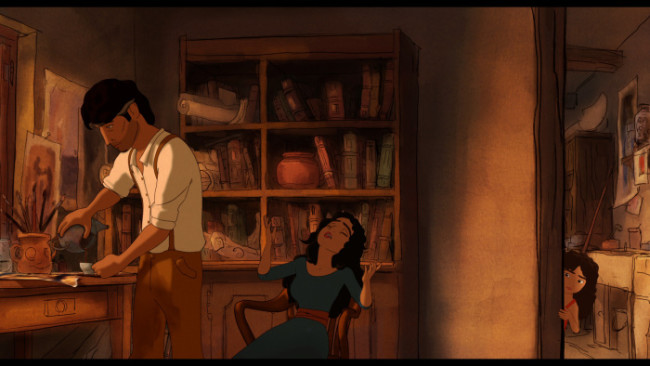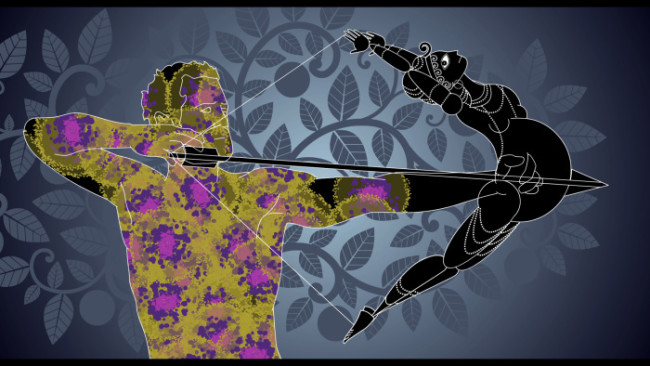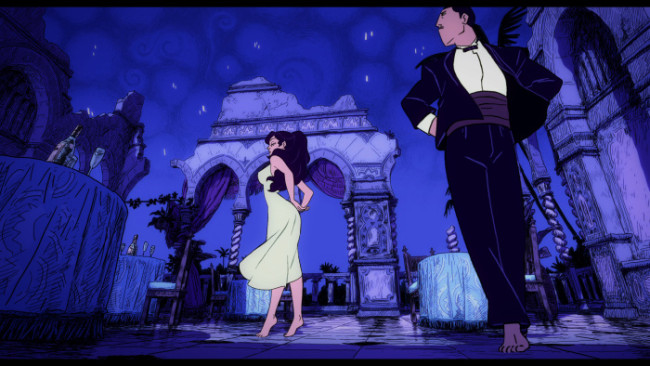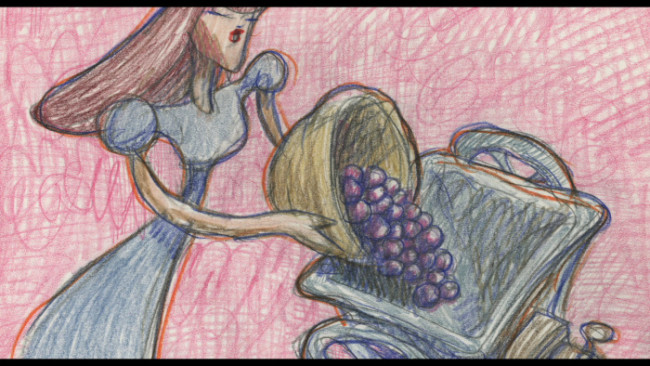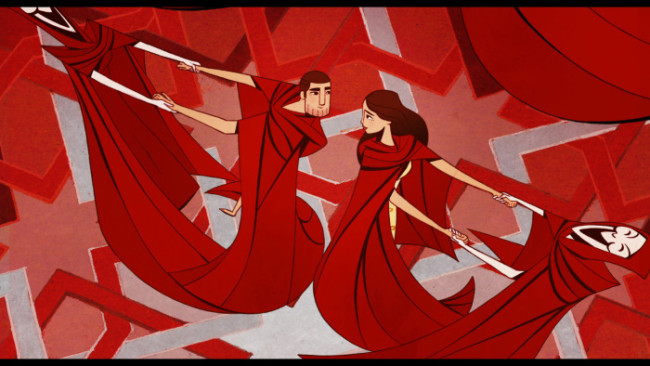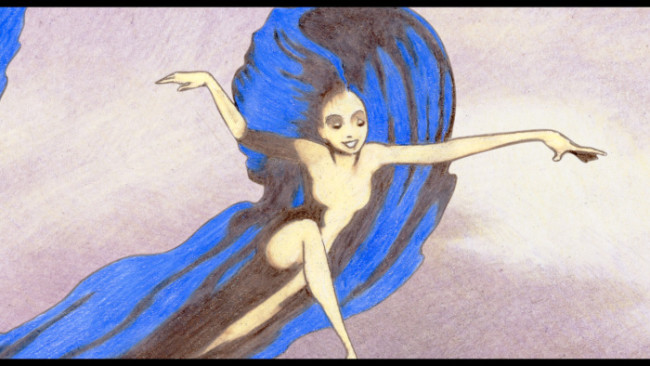Al-Mahjar: Q&A with the director of The Prophet
Almost 100 years ago, in a land almost 5000 miles away from New York City, a man named Almustafa was kept under house arrest for his visionary and powerful voice. One day, he is released from his home by the city of Orphalese, and allowed to return home. As he traveled from his mountaintop to the sea-port, Almustafa encounters villagers and speaks to them of freedom, children, love, work, life, and death.
This is the story of The Prophet, written by Kahlil Gibran in 1923, and adapted into an animated feature film in 2015 by Selma Hayek (star of Frida) and directed by Roger Allers (The Lion King). Kahlil was a Lebanese poet, artist, and writer, whose family immigrated to Boston, Massachusetts. His parents were Maronite-Catholics in a city under the semi-autonomous rule of the Ottoman Empire. As a teenager, Kahlil returned to spend several years in Lebanon, before returning to America and then moving on to study art in Paris.
After a few years of French schooling, he returned to the USA to spend his life writing and painting and mingling with many other artists. Kahlil Gibran was part of a small group of Lebanese authors known as “the immigrants” “al-mahjar.” He died in New York in 1931 from tuberculosis.
The Prophet as a book is not much more than a collection of poems tied together loosely by (Al)Mustafa’s journey. But as a movie, it is more fleshed out. Selma Hayek added a young girl, named Almitra after one of the original characters, (voiced by Quvenzhané Wallis, Annie) who is the daughter of the maid Kamila (Selma Hayek) who tends the house of Mustafa (Liam Neeson). It’s no coincidence that Selma Hayek has an 8 year old daughter of her own.
As one fellow animator describes it, the movie starts out like Aladdin as Almitra is caught stealing in the market place. It is revealed that her father has recently passed away, (shot off-screen like Bambi) and that this tragedy has silenced her voice. Her mother is exasperated but loving. Almitra (and her seagull friend, which she sometimes imitates) starts to listen to the comforting words of Mustafa, finding refuge in his words and paintings.
Eventually, two soldiers The Sergeant (Alfred Molina) and Halim (John Krasinski) arrive to escort Mustafa “into freedom” and to a boat which will take him to his home country. Where this homeland resides is unclear. Things are not what they seem however, and only Almitra can save him.
Just as in the book, Mustafa makes speeches or poems to various characters and people he meets. In the movie, each poem is self contained in a separate piece of animation that is directed by an outside animator [described below]. The multitude of styles gives an ethereal quality to his words, juxtaposed with the 3d CGI modeled animation of the ‘real’ world of Almitra, the flat color toon-shading of their bodies, and the watercolor backgrounds outlined by scraggly pen.
After the screening at the New York International Children’s Film Festival on Sunday March 22nd, director Roger Allers and animator Joan C. Gratz were on hand to answer questions. Children, I find, make hilarious and cute reporters, and can sometimes come up with thoughtful insights.
It took several years for the director to get all the rights for the book, and it was a long process to organize all the animators together. In fact, the separate teams of animators did not even meet until various screenings of the finished film in France. It was hard to envision how all the poems would fit into a long narrative; how it would transition in and out of the story to poems was “a journey of faith.” Some people were difficult and chose poems that were not written in the script!
Joan Gratz paints her clay animation with her pointer finger, her “most talented finger,” until it gets so sore the fingerprint wears off and it’s too sensitive to use. She doesn’t like to work with the other finger because they block her view of her work, but the show must go on. She spent 6 months on storyboards, incorporating imagery from Gibran’s original artwork, and then another 6-8 months animating frame by frame. The production of the entire movie took about 2.5 years.
After one child asked why we didn’t see what happened to the bad guys in the end, Roger Allers advised him that directors always have to pick and choose what part of the story to actually show. If the kid was directing the movie, then he would show the bad guys’ ending because that’s what he thought was important.
Someone else asked why pick this story of The Prophet at all, when it was just someone walking to a ship. Allers replied that the story lets your mind go and develop where it may, and he drew upon his own experiences abroad in Crete. Selma Hayek always saw the book The Prophet on her grandfather’s nightstand, but as a child it had more of an impact on her as a symbol, rather than the text itself.
One girl pleasantly surprised Rogers Allers by observing that Almitra bonded with Mustafa because she saw him as a replacement father figure. He told her that it was a renewed sense of loss that spurred her to talk. When someone asked why they didn’t show the death of Almitra’s father in the beginning, Allers said: “Because I really wanted the story to focus on Mufasa… no wait, Mustafa!” to the amusement of everyone.
Finally, OF COURSE one kid asked how many drawings did they have to make for the film. Roger Allers said he was no mathematician but that you could calculate how many drawings because “for every one second of film, there are 24 drawings, well… except for Bill Plympton.”
“In truth that which you call freedom is the strongest of these chains, though its links glitter in the sun and dazzle the eyes.”
The “On Freedom” section was produced, directed, designed, animated by Michał Socha. Socha is a Polish animator who is famous for his short film Chick (which if you didn’t see at ASIFA-East’s Polish School of Animation last year, then shame on you) and for a The Simpsons couch gag. [He is not to be confused with the actor of similar name who plays The Knave on Once Upon a Time!!]
In a barren white desert with immense blue sky, a flock of all different kinds of birds peck at seeds in the wasteland. They look like sponge-paint, and are in fact computer models that were repainted with pastel effects. They are lured into bird cages on the ground, which suddenly trap them and form the shape of a man that walks away. The cage-man reaches a giant black tree and the wires transform to tie each bird to its branches. The birds are susceptible to all sorts of predation, but through their persistence they achieve their own sort of freedom.
“Your children are not your children…And though they are with you yet they belong not to you.”
“On Children” is produced, directed, designed, animated by Nina Paley (Sita Sings the Blues, Illinois, USA).
Grey fuzzy cells under go mitosis on a shifting geometric background of interleaved straws. A mother bird protects its young in the branches of a tree while a human mother protects her child from the rain. The child runs , a forest cycling through the seasons, and its body grows older into a copy of its mom. She leaps and arches back and assumes the shape of a bow with a pregnant belly, held taught until released and and arrow flies out and she is not pregnant.
The arrow becomes birds or trees or people and another child, another pregnancy, another bow over and over, the mom turning into a skeleton and falling away each time, with a rotoscoped giant man firing the arrows. The women are crafted out of Paley’s signature style puppets with simple but intricate ornamentation.
“Love one another, but make not a bond of love: … For the pillars of the temple stand apart,”
“On Marriage” is produced by Antoine Delesvaux, Clement Oubrerie, and Joann Sfar, with choreography by Philippe Decoufle; and animation directed by David Garcia. Antoine Delesvaux also produced The Rabbi’s Cat (2011) which also premiered at the New York International Children’s Film Festival.
A barefoot tango in a ruined temple hotel: crumbled fallen walls of ancient times are decorated with unused dining tables, once magnificent. A man and woman enter in black tie and white gown, their fingers flicker and eyes gesture to castanet tempo. The woman has dashed lines under her eyes, they dance and court each other solemnly, knowingly, professionally, the tablet-drawn animation exaggerates perspective as limbs swing towards and away from the camera, maintaining stylized forms even through poses, not too obviously humaniform as rotoscope, pushing curves of legs more with less concern to consistent volume.
At one point in the music, or in the telling of the poem, their passionate dance flips a champagne glass into the air with a soft ping, and in slow motion we watch them gasp at its flight, falling to the floor with a shatter. This leads to an elegant soft footed ronde-de-jamb of the woman’s feet pushing the shards away from her, and the man lifts her up and away from the debris to another part of the dance floor. One lovely sequence of lifts where the woman appears to be daintily walking but is weightlessly held by her partner. Not only is Philippe Decoufle a contemporary choreographer but he is also a mime.
“Work is love made visible.”
“On Work” is produced, directed, designed, animated by Joan Gratz (Mona Lisa Descending a Staircase, 1992, Oregon, USA).
An intense “clay-fingerpainting” animation. A man harvests a Van Gogh field of wheat, scooping husks and seeds and dirt. Images flow into hands and babies and more, almost overwhelmingly fluid, cascading to the poetry.
“But since you must kill to eat,… let it then be an act of worship,”
“On Eating and Drinking” is directed, designed, animated by Bill Plympton (Cheatin’ playing soon Oregon, USA).
First of all, a man eats a rainbow out of a flower. An attractive pair of man and woman create, serve and eat farm fresh food. It is unclear whether they are growing food or themselves.
“On Love” is directed and designed by Tomm Moore (The Song of the Sea, Ireland) along with a nice group of people.
A brown haired man and woman embrace and sway with love, lost in a wonderland of stylized grasses and fields. They are folded into hair and landscape and gold in imitation of The Kiss by Klimt. Their love attracts the attention of red ballroom masked dancers (Eyes Wide Shut with clothes, or maybe V for Vendetta), all men and women identical to each other. They seek to claim the couples love for their own and lure them away to dance, the further the man and woman move apart the more they start to look like the rest of the waltzers, but they break free and reunite in a kiss bonding them forever.
“For what is evil but good tortured by its own hunger and thirst?”
“On Good and Evil” is directed, designed by Mohammed Saeed Harib (FREEJ, 1st Middle Eastern 3d cartoon animator, Dubai, UAE), and more crew.
A soft but sinister investigation in watercolor of a seed taking root, a comparison of red, black, and white of a tree growing on a waterfall, how seeds give and roots take, each to its own nature. Deer are in the forest, the stag’s horns are made of Arabic writing. They notice a fire coming and the deer take flight, passing turtles, who slowly plod to the river. The turtles become just as flightful as the deer once they hit the water. A comparison of kinds of strengths, the deer seem to have the advantage till they are stuck by the waterfall cliffs, and the turtles dive. Eventually the deer jump after the stag takes the plunge.
“For life and death are one, even as the river and the sea are one.”
“On Death” is produced, directed, designed, animated by Paul Brizzi and Gaetan Brizzi (twin French animators, worked on Babar TV show and directed the Firebird sequence in Fantasia 2000)
A pale white figure appears out of a black river and wraps herself up in a cape, a river, her hair, moving, gesturing forwards into a gloomy forest, afraid of shadows and light. They make it finally into the open, disappearing, then reappearing, bursting out of a flower bud as a plant person, tumbling in the sunlight, bursting into flame as a fire person, falling into ash, back to the river. They drink from the river “Only when you drink from the river of silence shall you indeed sing.” The sylph moves up a mountain crag with an animal gait, climbing on fours, at the summit she dances down into the air transformed with self-confidence.
The Prophet will be released in NYC and LA on August 7th, and later on in the rest of the country. There is also a screening in DC at the end of April, which is all the hints I can give you. Stay tuned to the New York International Children’s Film Festival next year for more exciting films!
Check out a list of this year’s festival’s animated short and feature length winners here. In particular, I recommend one of the runner ups Tigers Tied up in One Rope by Benoit Chieux, France 2014.
That’s all for now! Tristian signing off.
(Images via Variety Latino; h/t, Cartoonbrew)


